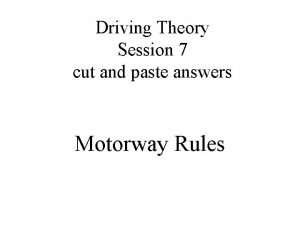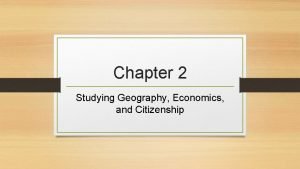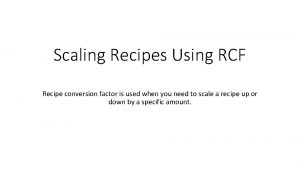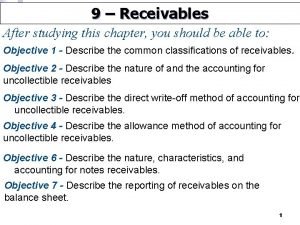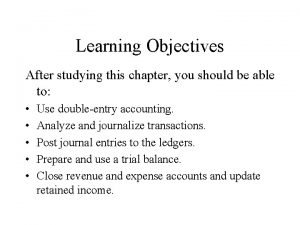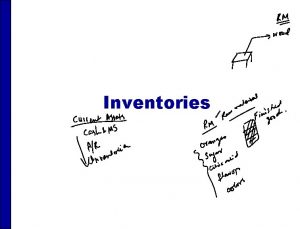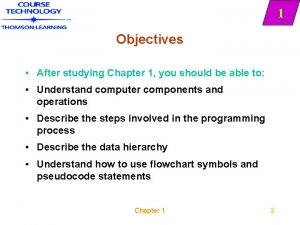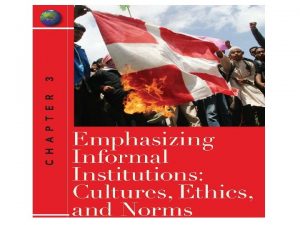Survey Research After studying this chapter you should










- Slides: 10

Survey Research After studying this chapter, you should be able to 1. Define surveys and explain their advantages 2. Describe the type of information that may be gathered in a survey 3. Identify sources of error in survey research 4. Distinguish among the various categories of surveys © 2010 Cengage Learning. All rights reserved. May not be scanned, copied or duplicated, or posted to a publically accessible website, in whole or in part. 1

Survey Research • Respondents Ø People who verbally answer an interviewer’s questions or provide answers to written questions. • Sample Survey Ø A survey that emphasizes contacting respondents who are a representative sample of the target population. © 2010 Cengage Learning. All rights reserved. May not be scanned, copied or duplicated, or posted to a publically accessible website, in whole or in part. 2

Using Surveys • Survey Objectives Ø Surveys attempt to describe what is happening, what people believe, what they are like, or to learn the reasons for a particular business activity. Ø Survey research is descriptive research: v Identifying characteristics of target markets v Measuring consumer attitudes v Identifying information regarding activities that could make the company more “green” Ø Surveys can be both quantitative and qualitative. © 2010 Cengage Learning. All rights reserved. May not be scanned, copied or duplicated, or posted to a publically accessible website, in whole or in part. 3

Advantages of Surveys • Advantages of Surveys Ø Gathering information via surveys is: v Quick v Inexpensive v Efficient v Accurate © 2010 Cengage Learning. All rights reserved. May not be scanned, copied or duplicated, or posted to a publically accessible website, in whole or in part. 4

Respondent Error • Self-Selection Bias Ø A bias that occurs because people who feel strongly about a subject are more likely to respond to survey questions than people who feel indifferent about it. © 2010 Cengage Learning. All rights reserved. May not be scanned, copied or duplicated, or posted to a publically accessible website, in whole or in part. 5

Response Bias • Deliberate Falsification Ø Occasionally people deliberately give false answers. v Misrepresent v Conceal v Avoid answers to appear intelligent personal information embarrassment © 2010 Cengage Learning. All rights reserved. May not be scanned, copied or duplicated, or posted to a publically accessible website, in whole or in part. 6

Types of Response Bias • Acquiescence Bias Ø A tendency to agree with all or most questions. • Extremity Bias Ø The tendency of some Individuals to use extremes when responding to questions. • Interviewer Bias Ø The presence of the interviewer influences respondents’ answers. © 2010 Cengage Learning. All rights reserved. May not be scanned, copied or duplicated, or posted to a publically accessible website, in whole or in part. 7

Classifying Survey Research Methods • Structured/Unstructured Questionnaires Ø Structured question: imposes a limit on the number of allowable responses. Ø Unstructured question: does not restrict respondents’ answers. • Disguised/Undisguised Questionnaires Ø Undisguised questions: assume the respondent is willing to answer. Ø Disguised questions: assume the purpose of the study must be hidden from the respondent. © 2010 Cengage Learning. All rights reserved. May not be scanned, copied or duplicated, or posted to a publically accessible website, in whole or in part. 8

Classifying Survey Research Methods (cont’d) • Temporal Classification Ø Cross-sectional study: various segments of a population are sampled and data are collected at a single moment in time. © 2010 Cengage Learning. All rights reserved. May not be scanned, copied or duplicated, or posted to a publically accessible website, in whole or in part. 9

Categorizing Survey Research Methods (cont’d) • Temporal Classification (cont’d) Ø Longitudinal study: A survey of respondents at different times, thus allowing analysis of response continuity and changes over time. v Tracking study: uses successive samples to compare trends and identify changes in variables such as consumer satisfaction, brand image, or advertising awareness. v Consumer panel: a survey of the sample of individuals or households to record (in a diary) their attitudes, behavior, or purchasing habits over time. © 2010 Cengage Learning. All rights reserved. May not be scanned, copied or duplicated, or posted to a publically accessible website, in whole or in part. 10
 After me after me after me
After me after me after me If any man will come after me
If any man will come after me Reflective studs colours on motorway
Reflective studs colours on motorway Imagine you are studying english
Imagine you are studying english A polysaccharide you are studying contains unbranched
A polysaccharide you are studying contains unbranched Abcde acls
Abcde acls Chapter 24 studying the sun
Chapter 24 studying the sun Lesson 1 studying geography
Lesson 1 studying geography Studying geography economics and citizenship
Studying geography economics and citizenship What does rcf stand for in cooking
What does rcf stand for in cooking I e.g. was at home yesterday
I e.g. was at home yesterday


